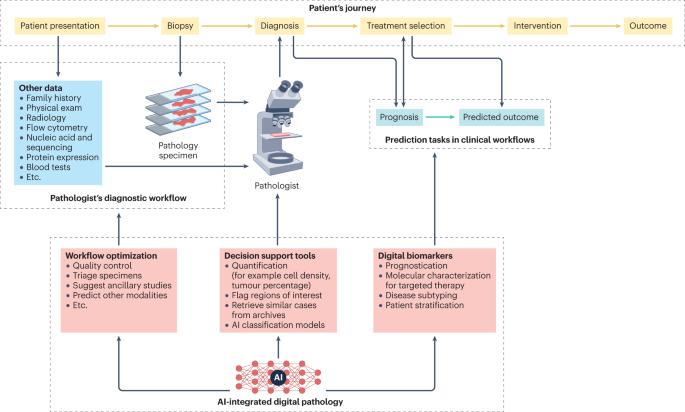Artificial intelligence applications in histopathology
引用次数: 0
Abstract
Histopathology is a vital diagnostic discipline in medicine, fundamental to our understanding, detection, assessment and treatment of conditions such as cancer, dementia and heart disease. Traditionally, the standard workflow in histopathology has primarily relied on the visual interpretation of tissue samples carried out by human experts under a light microscope. Since the 2000s, thanks to advances in scanning technologies such as whole-slide imaging, histopathology is undergoing a digital transformation. The rapid increase in digital data is fuelling the development and application of artificial intelligence (AI) methods. In this Review, we delve into the latest progress in AI methods for histopathology, which promise to yield accurate, scalable, useful and affordable support tools for clinical decision. We examine the challenges and opportunities in this domain, exploring historically important approaches and problems that have shaped the field, while also highlighting recent technological breakthroughs that are poised to redefine its future. Furthermore, we offer an overview of publicly available datasets that have been instrumental in propelling the development of AI methods in histopathology. Increase in clinical digital data is propelling the development and application of artificial intelligence methods in histopathology. In this Review, machine learning algorithms and models and their clinical use cases are discussed, highlighting the computational and operational challenges in the field.

组织病理学中的人工智能应用
组织病理学是医学中一门重要的诊断学科,是我们了解、检测、评估和治疗癌症、痴呆症和心脏病等疾病的基础。传统上,组织病理学的标准工作流程主要依靠人类专家在光学显微镜下对组织样本进行肉眼判读。自 2000 年代以来,由于全切片成像等扫描技术的进步,组织病理学正在经历一场数字化变革。数字数据的快速增长推动了人工智能(AI)方法的发展和应用。在本综述中,我们将深入探讨组织病理学人工智能方法的最新进展,这些方法有望为临床决策提供准确、可扩展、有用且经济实惠的支持工具。我们研究了这一领域的挑战和机遇,探讨了塑造这一领域的历史性重要方法和问题,同时还强调了有望重新定义其未来的最新技术突破。此外,我们还概述了对组织病理学人工智能方法的发展起到推动作用的公开数据集。临床数字数据的增加推动了组织病理学中人工智能方法的发展和应用。本综述讨论了机器学习算法和模型及其临床应用案例,并强调了该领域在计算和操作方面的挑战。
本文章由计算机程序翻译,如有差异,请以英文原文为准。
求助全文
约1分钟内获得全文
求助全文

 求助内容:
求助内容: 应助结果提醒方式:
应助结果提醒方式:


